Surface coating from UCLA and University of Chinese Academy of Sciences uses hierarchical micro- and nano-structures to elevate surface temperatures and shed condensed water droplets.
Benefits
- Adaptable
- Durable
- Versatile
Applications
- Automobiles
- Aviation
- Energy generation
UN Sustainable Development Goals Addressed
-

Goal 9: Industry Innovation & Infrastructure
The Challenge
In cold and humid environments, surfaces are particularly susceptible to ice formation. Unfortunately, these environments are also the most challenging to keep dry, and typical anti-icing methods tend to be temporary, ineffective, and costly. Thus, anti-icing surfaces that can maintain their ability to remove condensed water under extreme environmental circumstances are needed.
Innovation Details
The coating is a condensate self-removing solar anti-frost surface (CR-SAS), fabricated using pulsed laser deposition technology. The coating contains micro- and nano-structures that trap light, giving the surface excellent photothermal properties. Even in cold, humid environments, the coating is able to warm. The CR-SAS is also superhydrophobic to condensed water, so when droplets land on its surface, they are shed before being given the opportunity to freeze. The coating may be applicable in many anti-icing scenarios (e.g.., aircrafts flying through clouds, wind turbines operating in winter, and power transmission facilities working in extremely cold and humid regions).
Biomimicry Story
Wheatgrass plants have a hydrophobic surface that prevents water from pooling on their leaves. The leaves are covered in nanoscale bumps which keep liquids in droplet form, allowing them to easily roll off the surface.





